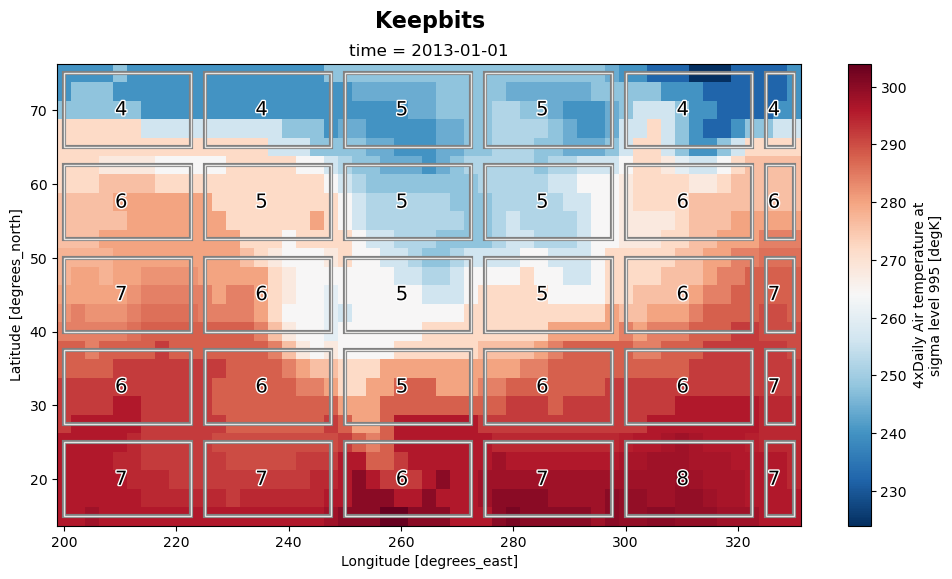Chunking#
Geospatial data can vary in its information density from one part of the world to another. A dataset containing streets will be very dense in cities but contains little information in remote places like the Alps or even the ocean. The same is also true for datasets about the ocean or the atmosphere.
By default the number of bits that need to be kept (keepbits) to preserve the requested amount of information is determined based on the entire dataset. This approach doesn’t always result in the best compression rates as it preserves too many keepbits in regions with anomalously low information density. The following steps show how the keepbits can be retrieved and applied on subsets. In this case, subsets are defined as dataset chunks.
This work is a result of the ECMWF Code4Earth 2023. Please have a look at the presentation of this project for additional details.
Imports#
from itertools import product
import numpy as np
import xarray as xr
import xbitinfo as xb
/home/docs/checkouts/readthedocs.org/user_builds/xbitinfo/conda/latest/lib/python3.12/site-packages/tqdm/auto.py:21: TqdmWarning: IProgress not found. Please update jupyter and ipywidgets. See https://ipywidgets.readthedocs.io/en/stable/user_install.html
from .autonotebook import tqdm as notebook_tqdm
Data loading#
# load data
ds = xr.tutorial.load_dataset("air_temperature")
# Defining chunks that will be used for the reading/bitrounding/writing
chunks = {
"lat": 5,
"lon": 10,
}
# Apply chunking
ds = ds.chunk(chunks)
ds
<xarray.Dataset> Size: 31MB
Dimensions: (lat: 25, time: 2920, lon: 53)
Coordinates:
* lat (lat) float32 100B 75.0 72.5 70.0 67.5 65.0 ... 22.5 20.0 17.5 15.0
* lon (lon) float32 212B 200.0 202.5 205.0 207.5 ... 325.0 327.5 330.0
* time (time) datetime64[ns] 23kB 2013-01-01 ... 2014-12-31T18:00:00
Data variables:
air (time, lat, lon) float64 31MB dask.array<chunksize=(2920, 5, 10), meta=np.ndarray>
Attributes:
Conventions: COARDS
title: 4x daily NMC reanalysis (1948)
description: Data is from NMC initialized reanalysis\n(4x/day). These a...
platform: Model
references: http://www.esrl.noaa.gov/psd/data/gridded/data.ncep.reanaly...Zarr chunking and compressing#
def bitrounding(chunk, var="lat"):
"""
Just a function that handles all the xbitinfo calls
"""
bitinfo = xb.get_bitinformation(chunk, dim=var, implementation="python")
keepbits = xb.get_keepbits(bitinfo, 0.99)
bitround = xb.xr_bitround(chunk, keepbits)
return bitround, keepbits
def slices_from_chunks(chunks):
"""Translate chunks tuple to a set of slices in product order
>>> slices_from_chunks(((2, 2), (3, 3, 3))) # doctest: +NORMALIZE_WHITESPACE
[(slice(0, 2, None), slice(0, 3, None)),
(slice(0, 2, None), slice(3, 6, None)),
(slice(0, 2, None), slice(6, 9, None)),
(slice(2, 4, None), slice(0, 3, None)),
(slice(2, 4, None), slice(3, 6, None)),
(slice(2, 4, None), slice(6, 9, None))]
"""
cumdims = []
for bds in chunks:
out = np.empty(len(bds) + 1, dtype=int)
out[0] = 0
np.cumsum(bds, out=out[1:])
cumdims.append(out)
slices = [
[slice(s, s + dim) for s, dim in zip(starts, shapes)]
for starts, shapes in zip(cumdims, chunks)
]
return list(product(*slices))
Save dataset as compressed zarr after compressing individual chunks#
%%capture
fn = "air_bitrounded_by_chunks.zarr" # Output filename
ds.to_compressed_zarr(fn, compute=False, mode="w") # Creates empty file structure
dims = ds.air.dims
len_dims = len(dims)
slices = slices_from_chunks(ds.air.chunks)
# Loop over each chunk
keepbits = []
for b, block in enumerate(ds.air.data.to_delayed().ravel()):
# Conversion of dask.delayed array to Dataset (as xbitinfo wants type xr.Dataset)
ds_block = xr.Dataset({"air": (dims, block.compute())})
# Apply bitrounding
rounded_ds, keepbit = bitrounding(ds_block)
keepbits.append(keepbit)
# Write individual chunk to disk
rounded_ds.to_zarr(fn, region={dims[d]: s for (d, s) in enumerate(slices[b])})
Plot#
import matplotlib.pyplot as plt
import matplotlib as mpl
import matplotlib.patheffects as pe
# # Create a figure and axis and plot the air temperature
fig, ax = plt.subplots(figsize=(12, 6))
rounded_ds = xr.open_zarr(fn).isel(time=0)
rounded_ds["air"].plot(ax=ax, cmap="RdBu_r")
slices = slices_from_chunks(rounded_ds.air.chunks)
for i in range(len(slices)):
# Get chunk limits
dss = rounded_ds.isel(lat=slices[i][0], lon=slices[i][1])
lats = dss.lat
longs = dss.lon
x = float(min(longs[0], longs[-1]))
y = float(min(lats[0], lats[-1]))
w = float(abs(longs[0] - longs[-1]))
h = float(abs(lats[0] - lats[-1]))
# Draw rectangle
rect = mpl.patches.Rectangle(
(x, y),
width=w,
height=h,
facecolor="none",
edgecolor="#E5E4E2",
path_effects=[pe.withStroke(linewidth=3, foreground="gray")],
)
ax.add_patch(rect)
# Annotate number of keepbits
rx, ry = rect.get_xy()
cx = rx + rect.get_width() / 2.0
cy = ry + rect.get_height() / 2.0
ax.annotate(
f"{int(keepbits[i].air):2}",
(cx, cy),
color="k",
weight="normal",
fontsize=14,
ha="right",
va="center",
path_effects=[pe.withStroke(linewidth=2, foreground="w")],
)
fig.text(0.39, 0.94, f"Keepbits ", weight="bold", fontsize=16)
plt.show()

Reference compression#
For comparision with other compression approaches the dataset is also saved as:
uncompressed netCDF
lossless compressed zarr
lossy compressed zarr while preserving 99% of bitinformation
Saving to uncompressed NetCDF file#
# Saving the dataset as NetCDF file
ds.to_netcdf("0.air_original.nc")
/home/docs/checkouts/readthedocs.org/user_builds/xbitinfo/conda/latest/lib/python3.12/site-packages/IPython/core/interactiveshell.py:3577: SerializationWarning: saving variable air with floating point data as an integer dtype without any _FillValue to use for NaNs
exec(code_obj, self.user_global_ns, self.user_ns)
Save dataset as compressed zarr (without bitrounding)#
fn = "air_compressed.zarr" # Output filename
ds.to_compressed_zarr(fn, mode="w") # Creates empty file structure
Save dataset as compressed zarr after applying bitrounding#
%%capture
fn = "air_bitrounded.zarr" # Output filename
rounded_ds, keepbits = bitrounding(ds)
rounded_ds.to_compressed_zarr(fn, mode="w")
Summary#
Below are the file sizes resulting from the various compression techniques outlined above.
!du -hs *.nc *.zarr
7.5M 0.air_original.nc
812K air_bitrounded.zarr
1.1M air_bitrounded_by_chunks.zarr
7.7M air_compressed.zarr
In this experiment, the sizes are minimized when applying bitrounding and compression to the dataset chunks.
However, it’s important to note that this outcome may not be universally applicable, check this for your dataset.